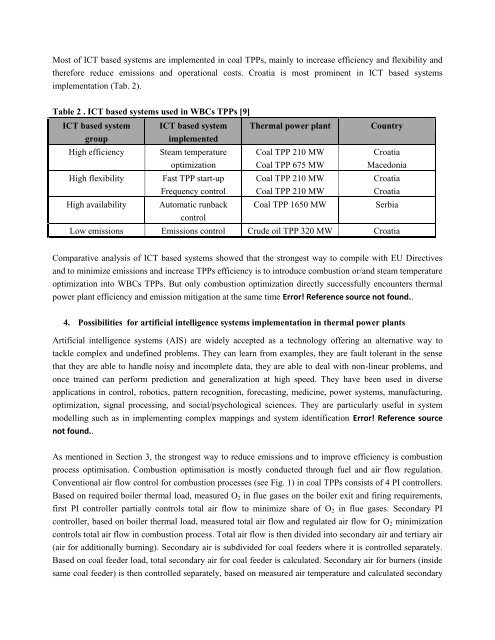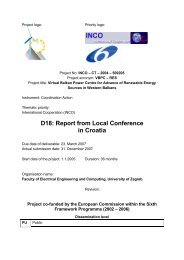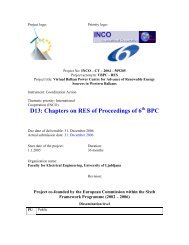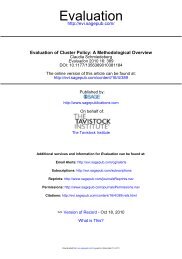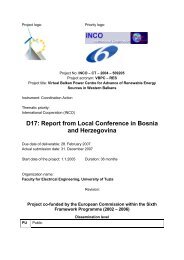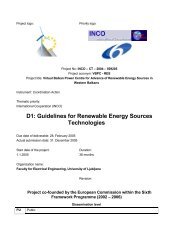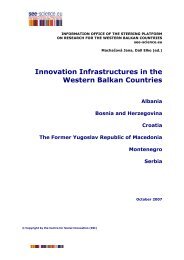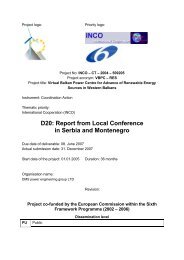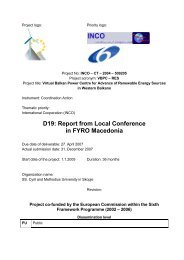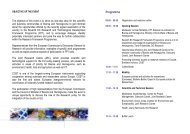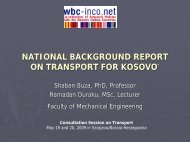Improvement of Environmental Aspects of Thermal Power Plant ...
Improvement of Environmental Aspects of Thermal Power Plant ...
Improvement of Environmental Aspects of Thermal Power Plant ...
Create successful ePaper yourself
Turn your PDF publications into a flip-book with our unique Google optimized e-Paper software.
Most <strong>of</strong> ICT based systems are implemented in coal TPPs, mainly to increase efficiency and flexibility and<br />
therefore reduce emissions and operational costs. Croatia is most prominent in ICT based systems<br />
implementation (Tab. 2).<br />
Table 2 . ICT based systems used in WBCs TPPs [9]<br />
ICT based system<br />
group<br />
ICT based system<br />
implemented<br />
High efficiency Steam temperature<br />
optimization<br />
<strong>Thermal</strong> power plant Country<br />
Coal TPP 210 MW Croatia<br />
Coal TPP 675 MW Macedonia<br />
High flexibility Fast TPP start-up Coal TPP 210 MW Croatia<br />
High availability Automatic runback<br />
Frequency control Coal TPP 210 MW Croatia<br />
control<br />
Coal TPP 1650 MW Serbia<br />
Low emissions Emissions control Crude oil TPP 320 MW Croatia<br />
Comparative analysis <strong>of</strong> ICT based systems showed that the strongest way to compile with EU Directives<br />
and to minimize emissions and increase TPPs efficiency is to introduce combustion or/and steam temperature<br />
optimization into WBCs TPPs. But only combustion optimization directly successfully encounters thermal<br />
power plant efficiency and emission mitigation at the same time Error! Reference source not found..<br />
4. Possibilities for artificial intelligence systems implementation in thermal power plants<br />
Artificial intelligence systems (AIS) are widely accepted as a technology <strong>of</strong>fering an alternative way to<br />
tackle complex and undefined problems. They can learn from examples, they are fault tolerant in the sense<br />
that they are able to handle noisy and incomplete data, they are able to deal with non-linear problems, and<br />
once trained can perform prediction and generalization at high speed. They have been used in diverse<br />
applications in control, robotics, pattern recognition, forecasting, medicine, power systems, manufacturing,<br />
optimization, signal processing, and social/psychological sciences. They are particularly useful in system<br />
modelling such as in implementing complex mappings and system identification Error! Reference source<br />
not found..<br />
As mentioned in Section 3, the strongest way to reduce emissions and to improve efficiency is combustion<br />
process optimisation. Combustion optimisation is mostly conducted through fuel and air flow regulation.<br />
Conventional air flow control for combustion processes (see Fig. 1) in coal TPPs consists <strong>of</strong> 4 PI controllers.<br />
Based on required boiler thermal load, measured O2 in flue gases on the boiler exit and firing requirements,<br />
first PI controller partially controls total air flow to minimize share <strong>of</strong> O2 in flue gases. Secondary PI<br />
controller, based on boiler thermal load, measured total air flow and regulated air flow for O2 minimization<br />
controls total air flow in combustion process. Total air flow is then divided into secondary air and tertiary air<br />
(air for additionally burning). Secondary air is subdivided for coal feeders where it is controlled separately.<br />
Based on coal feeder load, total secondary air for coal feeder is calculated. Secondary air for burners (inside<br />
same coal feeder) is then controlled separately, based on measured air temperature and calculated secondary


